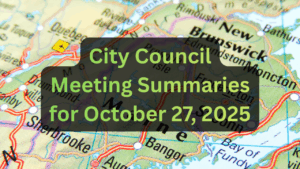
Mike Beck's summary of the Bangor City Council Budget Workshop held on Wednesday, May 21, 2025.
Disclaimer: The views I express here are my own and should NOT be construed as speaking for the City of Bangor or the City Council of Bangor.
The budget process has been expedited this year due to the departure of outgoing City Manager Deb Laurie. The goal is to prevent the incoming City Manager from having to defend a budget they didn’t write. Last night marked City Council getting close to the end of that process.
Wastewater Treatment (Sewer Department):
- The department operates primary and secondary wastewater treatment plants, managing hundreds of miles of infrastructure and treating approximately 7.7 million gallons of water daily (2.8 billion gallons annually).
- Recent upgrades include a new SCADA computer system.
- Significant work in the past year involved replacing 2,200 feet of sewer line, 40 manholes, inspecting and coding 27.5 miles of sewer pipe, and cleaning 70.5 miles of sewer pipe (a 51% increase).
- Challenges include the cost of chemicals, biosolids disposal (especially PFAS materials), and the regulatory environment, including a consent decree.
- Upcoming projects include renegotiating partnership agreements with Hampden and a portion of Hermon for wastewater treatment, an aeration project, and managing biosolids and PFAS.
- The budget is heavily weighted towards capital and supply costs rather than personnel, with personnel accounting for $2.7 million out of $11.7 million. Debt service and electricity are also major costs.
- A 5% increase in the service rate is included, aiming for gradual increases to cover operating costs. This was timed as the water district was not seeking a large increase this year.
- The department proposed nearly $13.5 million in capital items, with almost $2 million included in the budget, the rest to be funded by bonds, existing money, and potentially ARPA funds. The Kmart pump station is a priority due to dedicated ARPA funds.
- Regulatory reporting is increasingly time-consuming, involving both the sewer and engineering departments. A new, more challenging state discharge permit is anticipated.
Fire Department:
- The department is making progress on staffing, with four new recruits in training and another hiring event planned for June.
- Accomplishments include operating under a new contract, innovative in-house education with United Training, securing $200,000 in grant funding, completing radio infrastructure, and obtaining funding for a new training center and burn center.
- Challenges include balancing staff needs with service demands and managing responses to neighboring communities. Lead times for new fire trucks have almost doubled to three to four years.
- The budget is primarily personnel-based. Hydrant and equipment rental are the next highest costs. EMS response generates about $2.7 million in ambulance service fees.
- A request for a full-time training officer was noted but not included in the base budget.
- I argued in favor of the Fire Department training officer by highlighting several key points. I noted that the words “efficiency” and “consistency” jumped out to me regarding the position. I expressed that a lack of consistency can arise when multiple people are performing training duties and suggested that this position could potentially pay for itself, or at least subsidize itself, through the gains in efficiency and consistency. I also emphasized the importance of consistency for saving lives and educating the public, concluding that I thought it was a “good ask”.
- The capital plan includes $2.1 million, primarily for an engine replacement (to be bonded) and an annual ambulance replacement.
- A significant discussion occurred regarding the mental health crisis within the department.
- Actions being taken include bolstering the peer support group, policy development, and executive-level conversations to address the issue, with plans to engage professional services for surveys and to help build organizational support.
Parking Fund:
- This is an enterprise fund, self-sufficient through parking fees, permits, and tickets. A third-party contractor, PCI Municipal Services, manages the lots and structures.
- Recent improvements include new revenue control equipment at Pickering allowing mobile pay and video customer service, and implementation of a mobile parking app. The “Barnacle” device is being used for parking enforcement against those with substantial unpaid tickets.
- The Downtown Parking Advisory Committee is expected to reconvene soon with a quorum. An amnesty program for unpaid tickets is being considered before wider Barnacle implementation.
- About a third of the budget is personnel-related. Other costs include management fees, repairs, maintenance, insurance, utilities, and some debt service.
- The budget includes continued repairs on the 30-year-old Pickering Square garage and technology upgrades.
Cultural Commission:
- The Commission identifies cultural opportunities, manages a semiannual grant process, surveys cultural assets, and reviews public art proposals.
- The annual budget is typically $22,500. They requested an additional grant funding (to $25,000 total) due to increased requests and costs, and $2,000 for a new survey of cultural assets (last done in 2019), likely to hire a student.
- A discussion ensued about maintaining an inventory of city-funded cultural assets. While the city council approves public art, and a survey is done every three years by ordinance, a continuously updated inventory specifically for city-funded assets is not actively maintained by the commission. The possibility of adding cultural assets to the city’s asset management system was raised.
Fourth of July Funding:
- The city is working with the Kiwanis club regarding future July 4th events. The proposed budget increase to $12,500 would be for July 2026, as funding is done a year in advance. Last year’s funding was $5,000.
- Kiwanis may be stepping back from fundraising for fireworks due to a small number of active members, though they would continue the parade.
- The council discussed whether the city should solicit private donations for the event, which would require authorization.
- The original intent, as passed by motion in the April 7th Government Operations committee, was to reach out to the city of Brewer to discuss a joint venture for the fireworks display. Brewer still had not gotten back to the City Manager at the time of this meeting.
Snowmobile Club:
- The club maintains 30 miles of trails connecting Bangor to other areas and state ITS trails.
- The requested $3,000 is equivalent to the snowmobile registration fees the city receives and is a common practice to support volunteer trail maintenance.
School Budget and Overall Tax Impact:
- The school department provided updated information on special education funding (risen $1.3 million in six years to $8.8 million annually), enrollment numbers, vacant positions, and average cost per student.
- An additional reduction of $140,000 was made by the school department since Council’s last viewing of the school budget.
- The city staff also made reductions. The initial net increase to taxpayers was $1.8 million; the current figure is about $800,000.The city’s portion of the increase is almost flat at $124,000 (or $90,000 excluding overlay).
- This translates to a revised mill rate of $17.80 (down from an initial $18.00), resulting in an average residential tax bill increase of 4.19% or $171 (down from an initial projection of 7.8%).
- City-side reductions included not funding a left turn lane on Hammond Street ($140,000) and using alternate funding sources like draining the Cascade Park Trust account and utilizing current year savings.
- There was considerable debate about the school budget, with some councilors expressing concern over declining enrollment and increasing staff, while others emphasized the importance of fully funding schools and trusting the school committee’s process.
- The City Council voted to request that the school committee reduce its budget by $165,000. The motion passed on a majority vote.
Other Items:
- Targeted Property Tax Relief: I requested a discussion for a future workshop on implementing targeted property tax relief for older residents, similar to programs in other Maine communities. This will likely occur after the new city manager starts.
- Foreign Trade Zone (FTZ): Benefits include deferring tariffs, potentially increasing employment, providing a competitive edge, promoting Bangor as a logistics hub, and allowing local reinvestment. The city aims to assess fees to ensure no cost to the city for running the program.
- City Clerk’s Office Activity: During peak periods, the office collects about $700,000 a week in payments, with average delays of two weeks.
- FOAA Requests: The police department handles about 1,500 FOAA requests per year, with other departments handling an additional 150-200.
- Public Restrooms: The restroom by the library was raised as a significant concern due to behavioral issues.





